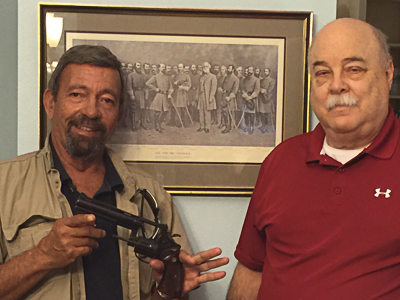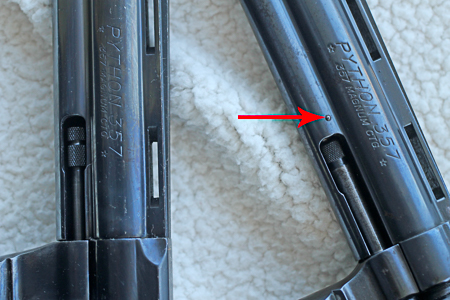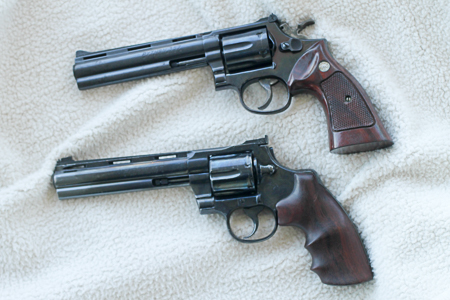Through the extremely generous good offices of my friend Chuck McDonald I now have a gun that has fascinated me for many years: a “Smython,” also known as a “Smolt.”
The brand rivalry of Colt versus Smith & Wesson is older than Ford versus Chevy or Coke versus Pepsi. In the third quarter of the 20th Century, gunsmiths started putting Colt Python barrels on Smith & Wesson revolvers (usually medium size K-frames, but occasionally the larger N-frames). Though it has been postulated that it was for one-handed bullseye shooting, my understanding has been that it was really for PPC, the Practical Police Course, shot on the tight-ringed B27 target with 24 of every 60 shots fired from 50 yards. The faster rifling twist of the Colt barrel generally made that brand a tiny bit more accurate than the slower-twist S&W barrels with .38 Special target loads. Why the Python barrel in particular, since the Python wasn’t introduced until 1955 and Colt had been making double action target revolvers on the same frame since the first decade of that century? Because the Python was the deluxe show-pony of the Colt line, and Colt engineers came up with the feat of tightening the bore by a thousandth of an inch from forcing cone to muzzle. This was believed to drive the lead bullet deeper into the rifling, resulting in the Colt’s slightly greater accuracy. The weighted full-length underlug beneath the barrel held the gun steadier on the tiny X-ring of the target: S&W didn’t make such a gun until circa 1980, when they came out with their Distinguished Combat Magnum L-frame series, models 586 (blue or nickel) and 686 (stainless), essentially an S&W copy of the Colt Python except that its rib atop the barrel did not have the Colt’s distinctive (if largely useless) “ventilating” cuts.
Why put a Python barrel on a Smith & Wesson instead of just buying the whole damn Python? Because most police revolver shooting in the PPC game (and of course, in defensive shooting in general) is done double action, and the Colt had a two-stage pull that “stacked,” or became a little harder at the end of the trigger stroke. The S&W was smooth and even all the way through a single pull, which most of us found more manageable.
Why else? “Because they COULD.” The S&W frame and the Colt barrel do not “mate” in nature, and it requires some pretty fancy machining to get that to happen. It was kind of like Smith & Wesson’s original Registered .357 Magnums from 1935, with fine grooves on the side of the hammer and checkering on the top of the frame that did nothing at all for the shooter but simply showcased how finely S&W could craft a handgun. The Python barrel on the S&W frame sorta gave the same showcasing of a gunsmith’s skills.
I’m not sure who the first gunsmith was to do this, but I think it may have been the great Bill Davis, in California. Because the S&W has been proven to work better with front-and-back lockup since around 1902, Davis laboriously installed a spring-loaded front ejector rod lug in the Python barrels of his conversions. Some other gunsmiths installed a ball-detent where the frame meets the cylinder yoke to lock the forward end of the cylinder in place. The specimen on my desk as I write this is not marked and has no written provenance as to the gunsmith, but the barrel-mounted front lug smacks strongly of Bill Davis’ work.
For frosting on the cake: Most of these guns were made on target-model Smith & Wessons with micrometer adjustable sights already installed. This one was done on a Model 13 “pinned and recessed” (S&W aficionados know what I’m talking about), which was a fixed sight .357 Magnum revolver. That means a great deal more machining had to be done to install adjustable sights, which were expertly and seamlessly melded onto this particular revolver. It also has the wide target hammer and target trigger, not normally sold with the service-style six-shooters.
A much smaller number of such fusions were made with Colt Python barrels on Ruger Security Six revolvers, which inevitably became known as Cugers or Cougers. Again, Bill Davis is the gunsmith most often associated with the conversion.
For more on the classic Colt Python itself, the 3-segment magnum opus I wrote on it almost 40 years ago for American Handgunner can be found here.
Yes, some of us gun collectors are into arcane minutiae. All I know is, I can’t wait to shoot this darn Smolt.
Thanks, Chuck!
Thanks, Chuck!
The “Smython,” a/k/a “Smolt.”
Compared to 6″ barrel Colt Python at left, the “Smython” at right has a front lug lockup for the S&W ejector rod. Arrow shows the pin which holds it in place. I suspect the fine hand of master gunsmith Bill Davis at work here.
“Smython,” top; below, for comparison, Jerry Moran custom Colt Python.







Sweet! Always wanted one of those – the best of both worlds, or so I always was willing to convince myself should the opportunity to pick one up present itself.
Congratulations on the new addition to the collection.
Beautiful revolver Mas,
I love a good classic revolver. Especially compared with the “Tupperware” toys we have today. Unfortunately, there is a whole new generation that thinks that revolvers are old and obsolete.
However, you can tell the difference just by holding a classic revolver in your hand. Shooting one (versus a modern striker semi-auto) is like the difference between eating on fine china versus plastic plates!
I have several revolvers myself including a S&W Model 19 Combat Magnum. I have been shooting this Model 19 since 1982 and it has never misfired or failed me yet. I cannot say the same about the semi-auto’s that I own. I had one plastic pistol that, when I first got it, I could not get through a single magazine without 1 or 2 malfunctions.
I have always lusted after a Colt Python (6-inch barrel in Colt Royal Blue, Please!) but, given their current prices, I could never afford one.
I thought that I knew something about revolvers but you just taught me something new. I did not know about the custom made “Smolts” until today. Thanks.
I’ve only seen one of those in person. That’s awesome you’ve got a piece of sixgun history there, Mas! Much as I teach the semi auto, I still have a soft place in my heart for the revolver.
Surely, this is weird and unnatural alchemy! j/k
Fantastic work. Needless to say it makes for a very unique piece.
Thanks for taking the time to highlight this firearm here for us, Mas.
Show the guts on one of the classic roller bearing Python conversions!!
Setting aside all the advertising baloney flowing out of modern gun companies, I’ve always found that vintage, prewar S&W and Colt revolvers (which I own) are much more accurate and refined than any currently made examples. But a “marriage” of both by a hot-stuff gunsmith, well that’s beyond my comprehension.
Very pretty Smython Mas! Congratulations on the new addition! I had never heard of the cross breeding before, though I did have a gent at a gun show try to sell me a “Troothon” or a “Pooper?” once. Someone had taken a 4″ Python barrel and put it on a Trooper frame and then hard-Chromed the whole contraption. I didn’t bite because I already had (have) a really sweet shooting 6″ Trooper, and was looking to trade a 6″ Python for a 4″ “Shooter” Python. (All the Pythons this fellow had were “Safe-Queens”.)
Having shot Colt Pythons, Detective Specials, Troopers, and several S&W revolvers (Models 19, 25, 325PD, 681, and 686) you are right about the Python and Detective Specials having triggers that stack when shot double action. Double action shooting is much easier on my Trooper and all of the S&W revolvers.
Now if I could only find a GOOD revolver-smith who could put BIGGER sights on my 4″ Model 681? I dearly LOVE the action and accuracy of that gun, but my old eyes cannot pick up those tiny fixed sights like they used to. I don’t really care about adjust-ability, but please make them Bigger!
We are in the Golden Age of Technology!
Wow. It’s been so long since those were made I’d forgotten they existed. I’ve never seen one except in a magazine. I’m going to bet it shoots like a dream. Both parent guns come from a time of true craftsmanship and built by a true craftsman. My buddy that owns a gun shop could tell you stories that’d make you cry about factory quality these days.
How bad did you have to hurt him to get that gun out of his hands?
The Smolt brings back memories! Why? Because they could and it was cool!
Thanks for the pictures and the explanation. I thought about the “Smython” the other day and told myself to do a computer search to find out why it was tried. I recalled something about the rifling of the Colt barrel, but that was all. I’d never heard about the .001′ tightening of the bore.
I too have learned something today concerning the python with a tapered bore.
S&W still thinks you can shoot .45acp in a revolver with a groove dia. of .454. That is .45Colt size. Yup, S&W Performance Center thinks it is just fine.
Mas – Thanks for piece about the piece. -g- Funnily enough IIRC the first article I ever read by you was about Sadowski’s custom Pythons. Waaaaaay back in issue one of ‘The Handgunner’ magazine.
Just don’t ever show us a Glock lower with a 1911 upper and all will be well!
TXCOMT
Coincidentally, I just saw a Smython like yours that someone else had bought a few days ago. I would probably buy one, too, if I could find one for an affordable price, just because I like old S&W and Colt revolvers. Like you, I have always preferred the S&W trigger pulls, because they are smooth & light, & they don’t stack like the Colts do. For me, though, a Smython would just be a collector’s item to have. I already have a pair of S&W 586’s & they are the most accurate of the many handguns that I own. I like them better than the Pythons. In my opinion, the original (pre-transfer bar) L-frame 586/686 is the perfect .357 Magnum revolver.
That’s a great article on a fine gun, regrettably, I never shot one, however, I never even got into handguns until much later. I’d really enjoy owning a fine revolver.
Another nice article. I still enjoy all your articles after all these years.
Stay well.
I like it when someone does something weird, odd or different just because they can, and it turns out well.
I was in a local gun shop a while back and spotted a firearm laying on the counter. At casual first glance I thought it was a shotgun, given the diameter of the barrel. Closer examination revealed it was a Browning BAR (the sporting version) re-barreled to .458 Win. Mag. I enthusiastically approved of the spirit of the person who decided to create such a wildly improbable rifle.
I wish all pistol/revolver manufacturers could make triggers as nice as S&W. The grit and creep one usually finds in a new handgun always disappoints me in comparison to Smith.
Mas, I recon this first encounter was when
Bill Davis built one on a M19 frame and presented
it to Bill Jordan many years back;
maybe. 40+. I’ll always recall the expression
both their faces ……Pure Joy.
By the way many of the Pythons
slugged out at .355- with 14 twist.
Much cheaper than Douglass or Shilen
1″ tubes with Bo-Mar or Aristocrat rib
sights complete with sight protector.
Our 16 year old son Jeremiah has taken
a sincere interest in shooting and reliability
of carried firearms. He throughly
enjoys shooting dad’s old 45 year old
Python.
Appreciate the notation on the JMCP
Drop us a line. engineering continues.
TRJM
I love this piece because I still have my 6″ Bill Davis manufactured “Smyhon”. Bill made my gun when he was still in his Sacramento place and I was a Sacramento Deputy Sheriff looking for a good compromise between a full Bull BBL PPC gun and a regular profile BBL to carry for a duty weapon. It still shoots like a dream.
Great article. It’s nice to see some revolver stuff these days in light of all the polymer guns that are out. I have two Smolts in front of me as I type this. First is a blued Model 15 4″ built by Mark Kearns, a former Bill Davis smith that is just beautiful. The second is a recent addition built by Craig Maraviov in Woodland, CA (another former Davis smith). It’s built on an S&W 686 with a 6″ Python barrel. It about the perfect Smolt, excellent balance and shoots like a mad dog. I’m fortunate to have two blued Python barrels on hand, a mint 4″ and new 6″ and I have a blued S&W 19-3 that will be heading to Craig within the next couple of weeks for another Smolt conversion. My only dilemma, which length to choose.
Comments are closed.